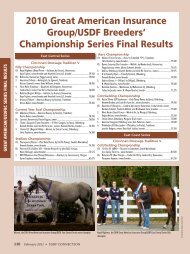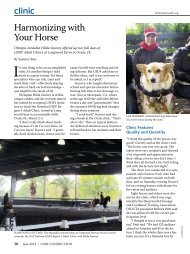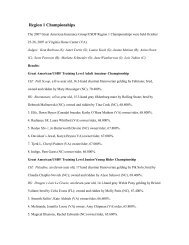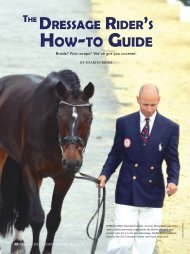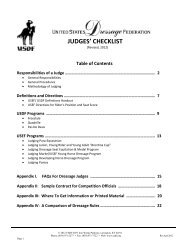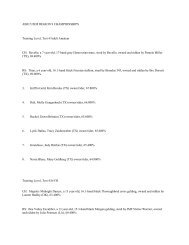Quadrille Rules
Quadrille Rules
Quadrille Rules
Create successful ePaper yourself
Turn your PDF publications into a flip-book with our unique Google optimized e-Paper software.
Training Level<br />
Clearly Forbidden:<br />
Any lateral work, counter-canter, simple change, flying changes, rein-back, turn-on-haunches or pirouette<br />
at walk, pirouette at canter, piaffe, passage.<br />
Clearly Allowed:<br />
Anything not clearly forbidden.<br />
First Level<br />
Clearly Forbidden:<br />
Rein-back, shoulder-in, travers, half-pass, flying changes, turn-on-haunches or pirouette at walk, pirouette<br />
at canter, piaffe.<br />
Clearly Allowed:<br />
Counter-canter (any configuration), leg-yield (any configuration), lengthen trot or canter on 20-meter<br />
circle, simple change, canter-halt, halt-canter.<br />
Second Level<br />
Clearly Forbidden:<br />
Half-pass, flying changes, pirouette at canter, piaffe, passage.<br />
Clearly Allowed:<br />
Full and double turn-on- haunches, renvers, travers, medium trot and canter on 20-meter circle, medium<br />
canter on diagonal.<br />
Third Level<br />
Clearly Forbidden:<br />
Tempi changes (4s, 3s, 2s, 1s), canter pirouette, piaffe, passage.<br />
Clearly Allowed:<br />
Everything that is not clearly forbidden, including: half-pass zigzag in trot, half-pass zigzag in canter with<br />
flying changes, full and double walk pirouettes.<br />
Fourth Level and FEI Levels<br />
Must state level. Follow USDF freestyle guidelines for what is clearly forbidden and clearly allowed (Third and Fourth<br />
Levels) and FEI Intermediate I and Grand Prix freestyle score sheets for what is forbidden/allowed.<br />
SCORING AND JUDGING<br />
Two (2) sets of marks are given—one for technical execution and one for artistic impression. Each set of marks is<br />
totaled separately, and then those totals are added together and converted to the final percentage score. In the case of<br />
two or more judges, scores will be averaged and these averages will comprise the competitor’s final score. The<br />
technical execution score mirrors that of the standard quadrille tests.<br />
UNDERSTANDING ARTISTIC IMPRESSION<br />
Choreography<br />
• Design<br />
The layout and construction of the pattern and combination of patterns.<br />
• Balance<br />
Use of space; the comprehensive use of the entire arena.<br />
• Direction<br />
Suitable balance between left and right.<br />
• Creativity (including degree of difficulty)<br />
The non-test-like nature and ingenuity of the patterns and combinations.<br />
• Difficulty<br />
Exceeding the requirement for the standard test of the same level.<br />
Musicality<br />
•Rhythm/tempo<br />
Appropriateness of rhythm and tempo to the gaits of the horses.<br />
• Cohesiveness<br />
Music selections are from one genre, style or theme.<br />
• Phrasing & dynamics<br />
Choreography reflects changes in the music.<br />
©2010 USDF USDF <strong>Quadrille</strong> <strong>Rules</strong>, Guidelines & Definitions<br />
Revisions follow the test cycle. Pg. 4



